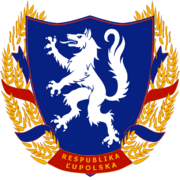Luepolan Defence Forces
This article is incomplete because it is pending further input from participants, or it is a work-in-progress by one author. Please comment on this article's talk page to share your input, comments and questions. Note: To contribute to this article, you may need to seek help from the author(s) of this page. |
| Luepolan Defence Forces | |
|---|---|
| Sile Obráňe Ľupolske | |
| Founded | 1818 |
| Current form | 1954 |
| Service branches | Luepolan Army Luepolan Air Force |
| Headquarters | Prishek |
| Leadership | |
| President | Savo Grigorević |
| Minister of Defence | Gavril Durević |
| High Marshal | Edvard Kraľ |
| Personnel | |
| Conscription | TBD |
| Active personnel | TBD |
| Reserve personnel | TBD |
| Expenditure | |
| Budget | $24.32 billion (2023) |
| Percent of GDP | 2.1% |
| Industry | |
| Domestic suppliers | Voitz Heavy Industries Rostva Naval Beľan-Matulić |
| Foreign suppliers | Lyskysten |
The Luepolan Defence Forces (Luepolan: Sile Obráňe Ľupolske; SOĽ), formerly known as the Luepolan Armed Forces (Luepolan: Vojsko Ľupolsko; VĽ), are the military forces responsible for the defense of Luepola. It is comprised of the Army, Navy and Air Force; prior to 1982, it also included the Home Guard. The military is nominally presided over by the Minister of Defence; in practice, it is largely subordinated to the General Staff of the Vierz Reichswehr, with multiple regiments directly integrated into Vierz divisions.
The Defence Forces trace their lineage to the peasant armies of Varadna-Strentland; the various militaries of Luepola have fought in many of the wars in Erisia from this period onwards. Since its formal reconstitution in 1989, the military has been primarily concerned with homeland defense as well as international peacekeeping missions under CECA and !UN mandates.
History
The Defence Force was constituted in its current form in 1954 by mandate of the Sliet, in conjunction with official sanction by the Vierz government and military. President Christian Dobrovitch referred to the formation of the Defence Forces as "an important step forward in the restoration of Luepolan nationhood in the modern age of peace and prosperity among brotherly nations." The reconstruction of a Luepolan military was almost entirely guided by Vierzland; military structure and doctrine was thus nearly mirrored from the Reichswehr, with very little doctrine retained from the preceding Luepolan People's Army. However, lower-ranking officers from the People's Army were consulted during the reconstruction process.
The Defence Force was active during the events of the March Uprising in 1979; in particular, the Army's refusal to crack down on protests and riots, and their occasional engagement of Luepolan Home Guard and police units, precipitated Zdrávko Kasun's fall from power. The Defence Force subsequently engaged the Vierz army in the Luepolan War; it prevented the rapid capture of critical infrastructure by Vierz Airborne forces during the first days of the war, but was gradually degraded over the following years by the Reichswehr.
Following the war, the Defence Forces were effectively put in stasis rather than disbanded outright as the People's Army was. Over the course of Vierz military governance of Luepola in the 1980s, Defence Force personnel were gradually vetted or replaced, and the Defence Force as a whole reconstituted into a smaller organization. The reconstituted Defence Force was subject to intense supervision by the Reichswehr, a policy which was discontinued in 1994. The new Defence Force operated as part of Reichswehr forces in the Invasion of Sulekh in 1989.
In 2004, the 24th Infantry Brigade of the Luepolan Army was integrated into the [unit TBD] of the Reichswehr, modeled after the integration of Defence Force units during the Sulekh campaign. The Defence Force would eventually integrate two-thirds of its combat-capable brigades into the Vierz military structure by 2018.
